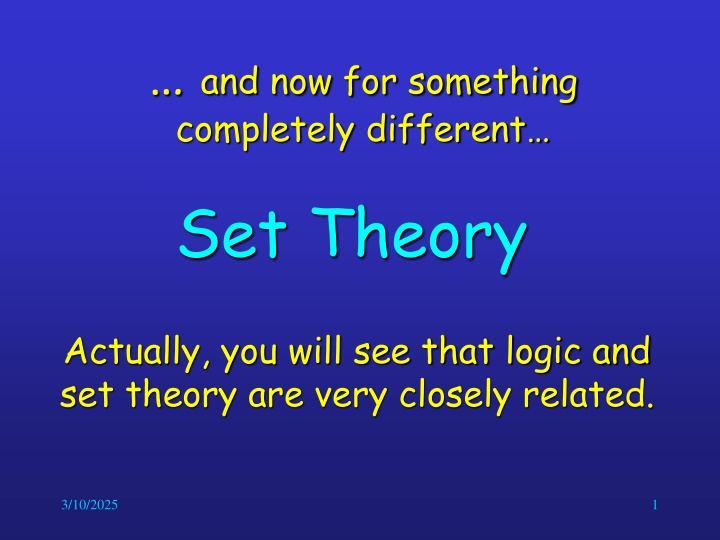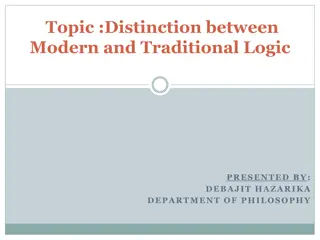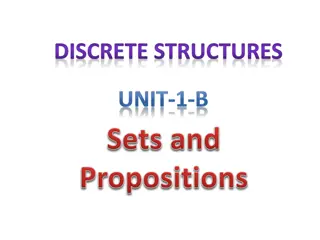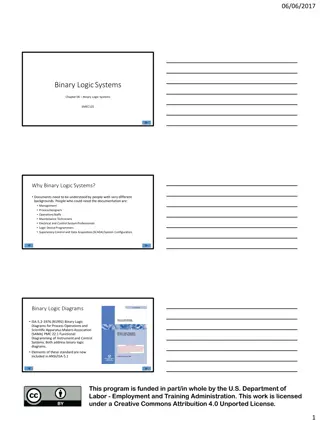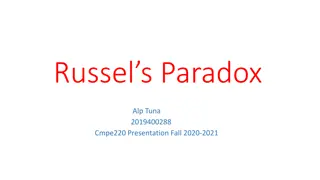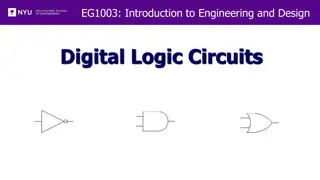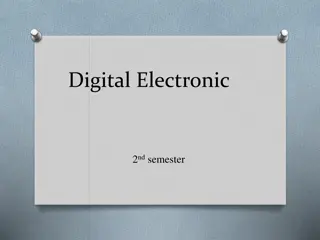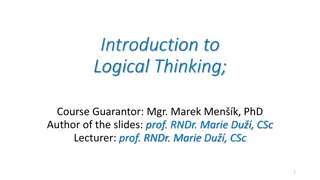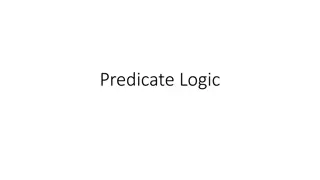Set Theory: Understanding Logic and Collections
Dive into the fascinating world of set theory where logic meets collections of objects. Learn about set equality, standard sets like natural numbers and real numbers, set builder notation, subsets, and useful rules in a visually engaging manner. Discover how sets are related to logic and explore the concept of elements, membership, equality, and subsets through clear examples and definitions.
Download Presentation

Please find below an Image/Link to download the presentation.
The content on the website is provided AS IS for your information and personal use only. It may not be sold, licensed, or shared on other websites without obtaining consent from the author.If you encounter any issues during the download, it is possible that the publisher has removed the file from their server.
You are allowed to download the files provided on this website for personal or commercial use, subject to the condition that they are used lawfully. All files are the property of their respective owners.
The content on the website is provided AS IS for your information and personal use only. It may not be sold, licensed, or shared on other websites without obtaining consent from the author.
E N D
Presentation Transcript
and now for something completely different Set Theory Actually, you will see that logic and set theory are very closely related. 3/10/2025 1
Set Theory Set: Collection of objects ( elements ) a A a is an element of A a is a member of A a A a is not an element of A A = {a1, a2, , an} A contains Order of elements is meaningless It does not matter how often the same element is listed. 3/10/2025 2
Set Equality Sets A and B are equal if and only if they contain exactly the same elements. Examples: A = {9, 2, 7, -3}, B = {7, 9, -3, 2} : A = B A = {dog, cat, horse}, B = {cat, horse, squirrel, dog} : A = {dog, cat, horse}, B = {cat, horse, dog, dog} : A B A = B 3/10/2025 3
Examples for Sets Standard Sets: Natural numbers N= {0, 1, 2, 3, } Integers Z= { , -2, -1, 0, 1, 2, } Positive Integers Z+= {1, 2, 3, 4, } Real Numbers R = {47.3, -12, , } Rational Numbers Q = {1.5, 2.6, -3.8, 15, } (correct definition will follow) 3/10/2025 4
Examples for Sets A = empty set/null set A = {z} Note: z A, but z {z} A = {{b, c}, {c, x, d}} A = {{x, y}} Note: {x, y} A, but {x, y} {{x, y}} A = {x | P(x)} set of all x such that P(x) A = {x | x N x > 7} = {8, 9, 10, } set builder notation 3/10/2025 5
Examples for Sets We are now able to define the set of rational numbers Q: Q = {a/b | a Z b Z+} or Q = {a/b | a Z b Z b 0} And how about the set of real numbers R? R = {r | r is a real number} That is the best we can do. 3/10/2025 6
Subsets A B A is a subset of B A B if and only if every element of A is also an element of B. We can completely formalize this: A B x (x A x B) Examples: A = {3, 9}, B = {5, 9, 1, 3}, A B ? true true A = {3, 3, 3, 9}, B = {5, 9, 1, 3}, A B ? false A = {1, 2, 3}, B = {2, 3, 4}, A B ? 3/10/2025 7
Subsets Useful rules: A = B (A B) (B A) (A B) (B C) A C (see Venn Diagram) U B C A 3/10/2025 8
Subsets Useful rules: A for any set A A A for any set A Proper subsets: A B A is a proper subset of B A B x (x A x B) x (x B x A) or A B x (x A x B) x (x B x A) 3/10/2025 9
Cardinality of Sets If a set S contains n distinct elements, n N, we call S a finite set with cardinality n. Examples: A = {Mercedes, BMW, Porsche}, |A| = 3 B = {1, {2, 3}, {4, 5}, 6} C = D = { x N | x 7000 } E = { x N | x 7000 } |B| = 4 |C| = 0 |D| = 7001 E is infinite! 3/10/2025 10
The Power Set P(A) power set of A P(A) = {B | B A} (contains all subsets of A) Examples: A = {x, y, z} P(A)= { , {x}, {y}, {z}, {x, y}, {x, z}, {y, z}, {x, y, z}} A = P(A) = { } Note: |A| = 0, |P(A)| = 1 3/10/2025 11
The Power Set Cardinality of power sets: | P(A) | = 2|A| Imagine each element in A has an on/off switch Each possible switch configuration in A corresponds to one element in 2A 5 4 3 2 1 A 6 7 8 x x x x x x x x x y y y y y y y y y z z z z z z z z z For 3 elements in A, there are 2 2 2 = 8 elements in P(A) 3/10/2025 12
Cartesian Product The ordered n-tuple (a1, a2, a3, , an) is an ordered collection of objects. Two ordered n-tuples (a1, a2, a3, , an) and (b1, b2, b3, , bn) are equal if and only if they contain exactly the same elements in the same order, i.e. ai = bi for 1 i n. The Cartesian product of two sets is defined as: A B = {(a, b) | a A b B} Example: A = {x, y}, B = {a, b, c} A B = {(x, a), (x, b), (x, c), (y, a), (y, b), (y, c)} 3/10/2025 13
Cartesian Product The Cartesian product of two sets is defined as: A B = {(a, b) | a A b B} Example: A = {good, bad}, B = {student, prof} A B = {(good, student),(good, prof),(bad, student),(bad, prof)} (student, good),(prof, good),(student, bad),(prof, bad)} B A = { 3/10/2025 14
Cartesian Product Note that: A = A = For non-empty sets A and B: A B A B B A |A B| = |A| |B| The Cartesian product of two or more sets is defined as: A1 A2 An = {(a1, a2, , an) | ai Ai for 1 i n} 3/10/2025 15
Set Operations Union: A B = {x | x A x B} Example: A = {a, b}, B = {b, c, d} A B = {a, b, c, d} Intersection: A B = {x | x A x B} Example: A = {a, b}, B = {b, c, d} A B = {b} 3/10/2025 16
Set Operations Two sets are called disjoint if their intersection is empty, that is, they share no elements: A B = The difference between two sets A and B contains exactly those elements of A that are not in B: A-B = {x | x A x B} Example: A = {a, b}, B = {b, c, d}, A-B = {a} 3/10/2025 17
Set Operations The complement of a set A contains exactly those elements under consideration that are not in A: Ac = U-A Example: U = N, B = {250, 251, 252, } Bc= {0, 1, 2, , 248, 249} 3/10/2025 18
Set Operations Table 1 in Section 1.5 shows many useful equations. How can we prove A (B C) = (A B) (A C)? Method I: x A (B C) x A x (B C) x A (x B x C) (x A x B) (x A x C) (distributive law for logical expressions) x (A B) x (A C) x (A B) (A C) 3/10/2025 19
Set Operations Method II: Membership table 1 means x is an element of this set 0 means x is not an element of this set A (B C) B C A B C A B A C (A B) (A C) 0 0 0 0 0 0 0 0 0 0 1 0 0 0 1 0 0 1 0 0 0 1 0 0 0 1 1 1 1 1 1 1 1 0 0 0 1 1 1 1 1 0 1 0 1 1 1 1 1 1 0 0 1 1 1 1 1 1 1 1 1 1 1 1 3/10/2025 20
Set Operations Every logical expression can be transformed into an equivalent expression in set theory and vice versa. 3/10/2025 21
